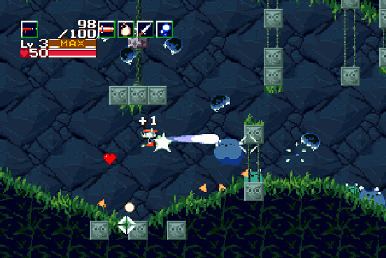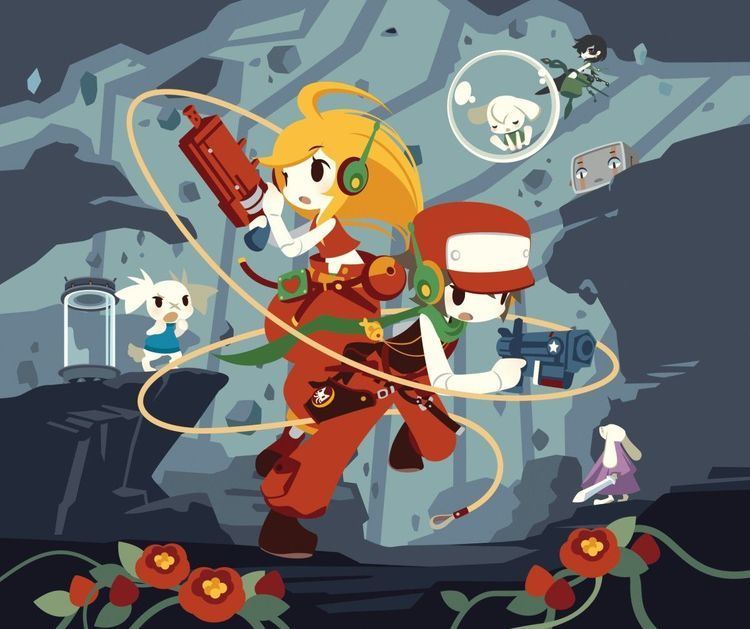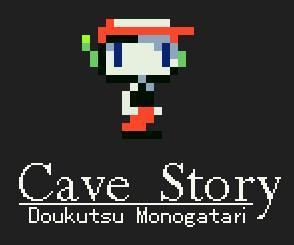10 /10 1 Votes10
Initial release date 20 December 2004 | 10/10 Steam Genre(s) Platform-adventure Designer Pixel | |||||||||||||||||||||||||||||||||
 | ||||||||||||||||||||||||||||||||||
Composer(s) Daisuke Amaya (all versions)Yann van der CruyssenNicklas Nygren (WiiWare, Plus)Danny BaranowskyDustin Kulwicki (3D, Plus) Release date(s) December 20, 2004Original versionWW: 20 December 2004WiiNA: 22 March 2010EU: 10 December 2010Nintendo DSiNA: 29 November 2010JP: 22 November 2011Nintendo 3DSNA: 4 October 2012EU: 1 May 2014JP: 30 September 2015Nintendo SwitchWW: 2017Cave Story 3DNA: 8 November 2011EU: 11 November 2011AU: 24 November 2011JP: 26 July 2012Cave Story+WW: 22 November 2011LinuxWW: 13 December 2011 Similar Pixel games, Platform games | ||||||||||||||||||||||||||||||||||
Cave story it starts in a cave part 1 steam train
Cave Story (洞窟物語, Dōkutsu Monogatari) is a freeware platform-adventure video game released in 2004 for the PC. It was developed over eight years by Daisuke "Pixel" Amaya in his free time. Cave Story features 2D platform mechanics and is reminiscent of the classic games Amaya played in his youth, such as Metroid (1986).
Contents
- Cave story it starts in a cave part 1 steam train
- Let s play cave story with nalif part 1 is that a lunch box
- Gameplay
- Setting
- Story
- Development
- Ports
- Cave Story
- Cave Story 3D
- Reception
- References

After its initial self-published release, Cave Story slowly gained popularity on the Internet. It received wide critical acclaim for its compelling story and gameplay. Independent developer Nicalis worked with Amaya to port the game to WiiWare and DSiWare in 2010. An enhanced version, Cave Story+, was released for Steam in November 2011, with a Nintendo 3DS release in October 2012. A 3D remake of the game, titled Cave Story 3D, was developed by Nicalis and published by NIS America for the Nintendo 3DS in November 2011.

The game focuses on an amnesiac protagonist who awakens in a cave. Through his explorations, he discovers a plot by the Doctor, a megalomaniac who intends to force the inhabitants of the cave to fight for him in his bid to conquer the world. The protagonist is thrust into the position of savior as he endeavors to defeat the Doctor.

Let s play cave story with nalif part 1 is that a lunch box
Gameplay

The player controls the on-screen character directly using the keyboard or gamepad. The player progresses by navigating platform game puzzles and shooting enemies with the equipped weapon. When the player collects multiple weapons, they may be toggled at any time with the press of a button. Defeating enemies sometimes yields yellow triangular objects, which give experience points to weapons when collected. Weapons may be improved up to level three, but taking damage causes weapons to lose experience and levels. Health and missile capacity upgrades are scattered throughout the game world. The player may interact with a variety of non-player characters and objects.
Setting
Cave Story takes place within the cavernous interior of a floating island. The island is populated by Mimigas, a race of sentient, rabbit-like creatures. A particular species of red flower that grows in the island causes the normally peaceful Mimigas, upon ingesting the flower, to temporarily grow to an abnormally large size with great strength and fall into a violent frenzy. The island also conceals an artifact called the Demon Crown, which has vast magical powers. An army of killer robots was sent to the floating island on a previous expedition, seeking to harness the Demon Crown as a weapon for wars on the surface world. These soldiers from the surface slaughtered Mimigas indiscriminately in their search for the crown. Shortly before the game begins, Professor Booster, the Sakamoto family, the "Doctor," and various assistants formed a scientific party to research the island, but they became stranded.
Story
The player character awakens in a cave with no memory of how he came to be there. He finds a village of Mimigas, who are being persecuted by the Doctor. The Doctor's servants Misery and Balrog are looking for Sue Sakamoto, a girl who had been transformed into a Mimiga. Not finding her, they mistakenly abduct another Mimiga named Toroko instead. The player finds Sue in the Egg Corridor, where she discovers the eggs of a Sky Dragon, which could allow her to escape the floating island if hatched. Sue attempts to rescue her brother Kazuma, but King, the leader of Mimiga Village, captures her and holds her responsible for Toroko's kidnapping. Sue tasks the player with retrieving Kazuma from Grasstown. After freeing him, they meet Professor Booster, who reveals that the Doctor plans to use the red flowers on Mimigas to create an army to take over the surface world. Booster sends the player to the Sand Zone to destroy the red flowers before the Doctor can find them. While there, the player meets Curly Brace, a female robot who also has no memories of her past, and Jenka, an old witch who is Misery's mother and guardian of the red flowers. Jenka calls the player character a "soldier from the surface", one of many who were sent to the island to slaughter the Mimigas. Balrog manages to obtain the key to the warehouse containing the red flowers from Jenka, who urges the player to stop them. Before the player can reach the warehouse, however, the Doctor samples a red flower on the captured Toroko and gravely injures King, and leaves the player to fight the rabid Toroko, who ultimately dies.
Misery transports the player to the Labyrinth deep inside the island as punishment for interfering with the Doctor's plans. Curly Brace has also been thrown into the Labyrinth and they cooperate to escape. Balrog helps them to move the boulder blocking the exit, revealing his kind nature. The pair find and defeat the Core, a magical creature whose power keeps the island afloat. However, the Doctor steps in to save it before the island collapses. Depending on certain conditions, the player may rescue Curly Brace, who had sacrificed her air tank to save the player character. When he returns to Mimiga Village, he finds that the Doctor has captured the Mimigas. In the Egg Corridor, Kazuma offers the player a choice to escape the island with him using a Sky Dragon, leading to an alternate ending in which the Doctor conquers the surface world while Kazuma and the player hide in the mountains. The player may instead choose to confront the Doctor and destroy the island's Core, which would return the Mimigas to normal. The player scales the outer wall of the island to reach the Plantation where the Doctor is using the Mimigas as slave laborers to grow red flowers. The Doctor's servants capture the player and place him in a jail cell with Sue. She is taken away before the player wakes up, but her letter reveals that the Doctor was a member of the research expedition that included Sue's family and Professor Booster, but he betrayed them once he found the Demon Crown. Sue directs the player to find her mother who may have a plan to stop the Doctor.
If the player saved Curly Brace earlier, the player may find an item to restore her memories. She remembers that the player character's name is Quote, and that they were not the killer robots who slaughtered Mimigas in the past. Instead, they were sent to destroy the Demon Crown to prevent its power from falling into the wrong hands. Quote finds Sue's mother, Momorin, who is building a rocket that will allow access to the top of the island where the Doctor resides. After helping her complete the rocket, Quote confronts Misery and the Doctor. The Doctor has purified the essence of the red flowers into a crystal, which allows him to survive even after Quote destroys his body. The Doctor's spirit possesses the Core of the island, but Quote succeeds in destroying that as well, causing the island to begin falling to Earth. Under certain conditions, the player may proceed into a bonus stage called the Bloodstained Sanctuary where the creator of the Demon Crown, Ballos, is imprisoned. Ballos, Jenka's brother, was a powerful wizard who went insane after being tortured. Misery forced Ballos to create the Demon Crown, but she and Balrog became cursed to serve whoever possessed it. With the help of Curly Brace, Quote defeats Ballos and stops the source of the negative energy that was causing the island to fall, saving its inhabitants. Balrog saves the two before they are crushed by Ballos' collapsing prison—he had been sent by Misery as thanks for breaking her curse. Quote, Curly Brace, and Balrog leave the island to live out their days in peace.
Development
Daisuke "Pixel" Amaya developed Cave Story in his free time over five years. He began the project when he was in college and continued working on it after getting a job as a software developer. He started by writing the title screen music and programming rudimentary character movements. The idea for the cave setting evolved spontaneously when he created a number of enclosed spaces. Amaya admitted this lack of planning caused "problems down the line" because he did not have dedicated map editing and data management tools. Amaya describes the game as having an "old-fashioned feel", reminiscent of the games he played as a child like Metroid. More importantly, this "retro" design choice allowed him to create a large volume of artwork on his own, which would have been impossible for a 3D game.
At a Game Developers Conference project post-mortem, he emphasized the role of pragmatic design in shaping the game. While designing the main character, Quote, Amaya drew inspiration from Mario's iconic original appearance—a large, expressive face and a high contrast between his white skin and red shirt make him stand out from the dark cave backgrounds. Most other characters feature either light skin or white clothes for the same reason. To make levels memorable, Amaya designed them around a single theme, such as "warmth" for the Egg Corridor or "arid and oppressive" for the Sand Zone. Instead of a tutorial level, a concept Amaya dislikes, the first level of the game gives the player two paths, one of which is blocked off until retrieving an item from the other path. This setup, inspired by the opening of Metroid, "lets players feel like they've solved problems on their own" and persists throughout the game. In beta versions of the game, all the enemies were shaped like bars of soap, a concept that evolved into the Balrog character. There was also a "frog prince" character who could travel through water more easily. Elements of this beta were incorporated into the Nintendo 3DS version of the game.
Ports
Cave Story has been ported to Linux, AROS, MorphOS, AmigaOS 4 and Mac OS X operating systems, PlayStation Portable, Xbox, Dreamcast, GP2X, GP2X Wiz, and the TI graphing calculator. An enhanced port, featuring updated character designs, remixed music and extra game modes, was developed by Nicalis and released on WiiWare on 22 March 2010 in North America and 10 December 2010 in Europe. Nicalis also ported the game to DSiWare on 29 November 2010 in North America and 22 November 2011 in Japan. Although it does not feature the enhanced graphics and sound or some of the extra modes from the Wii version, it does include the Sanctuary Attack mode. There is also a free/libre SDL-based recreation of the original game engine, titled NXEngine, made by programmer Caitlin Shaw, which allows for extended modification of the game, and the creation of ports for additional devices. The game was released for the Nintendo 3DS's Nintendo eShop service (separate from the retail 3DS game) in the United States on 4 October 2012 and in Europe on 1 May 2014. This version includes the DSiWare version's Jukebox mode, as well as all the additional modes included in Cave Story+. On January 19, 2017, Nicalis silently announced that the game will be released on the Nintendo Switch on an unspecified date.
Cave Story+
An enhanced PC version titled Cave Story+ was released by Nicalis on the Steam service on 22 November 2011. Cave Story + features an alternative script that differs from the original English translation. This version contains all the additional modes from the WiiWare version, a remastered soundtrack, as well as the option to toggle the style of graphics between the classic style and that of the WiiWare version and the music of the original game, the WiiWare port, or the 3DS update. It also features an exclusive 'Wind Fortress' level. Recently the game got an update that added exclusive Machine Gun Challenge. The game was included as a bonus game in the Humble Indie Bundle 4 sale in December 2011, Humble Bundle 7 in December 2012, and was released on the Desura service in April 2012.
Cave Story 3D
Cave Story 3D is a 3D version of the game developed by Nicalis and published by NIS America as a retail title for the Nintendo 3DS. It was released on 8 November 2011 in North America, 11 November 2011 in Europe and 26 July 2012 in Japan. The game was built from scratch using 3D character models, featuring a dynamic camera system and another additional level, as well as a remixed soundtrack by Danny Baranowsky. The Japanese version features crossover content from various NIS and other companies' franchises such as Crazy Climber, Ikki, and Dragon Slayer. In order to devote more time to perfecting the title, Amaya quit his job as a software developer to become director of Cave Story 3D. He remarked that the transition to 3D was difficult because it required the consideration of so many more details.
Reception
The original Cave Story earned widespread critical acclaim. 1UP.com described it as "so massive that it rivals modern [Game Boy Advance] Castlevania and Metroid games in terms of scope and play time". Matt Miller of Game Informer observed that Cave Story combines elements of Metroid, Ninja Gaiden, Mega Man, The Legend of Zelda, and Castlevania into an "engrossing, challenging, and quite lengthy" whole. Inside Mac Games ascribed the game's popularity to its "polished feel, engaging storyline, and compelling artwork". Electronic Gaming Monthly stated that "the burgeoning Western indie game scene owes a tremendous debt to Japanese pioneers like Studio Pixel, whose freeware hit Cave Story proved that with sufficient vision, skill, and passion, a single developer can still craft a deep, compelling action game". Jonathan Holmes of Destructoid called Cave Story an "important game", observing its influence on artistic indie games like Braid, as well as the continued relevance of 2D game design (cf. Capcom's Mega Man 9). He also compares the game design to that of Shigeru Miyamoto in its ability to teach without tutorials, like at the beginning of Super Mario Bros. In July 2006, Cave Story earned 1st place in Super PLAY's list of the 50 best freeware games of all time. In July 2015, the game placed 14th on USgamer's The 15 Best Games Since 2000 list.
The WiiWare version has received mostly positive reviews, with the central criticism being the 1200 Wii Point price tag (US$12, £10), after years of free play. Jeremy Parish of 1UP.com commended the graphical update, which "sacrifices none of [the game's] classic-influenced charm". He also remarked that the Classic Controller and Wii Remote are superior to the keyboard input of the PC original. On the issue of price, he explained that "the prospect of Amaya finally earning a little something for the hard work he invested in this masterpiece strikes me as satisfyingly poetic" and "absolutely worth your money". John Teti of Eurogamer had similar sentiments, but also noted the technical issues with the remixed music, recommending the original soundtrack. Edge compared the remake to The Secret of Monkey Island: Special Edition, satisfying both modern tastes with its graphical overhaul and old school fans with the option to switch to the original graphics. Daemon Hatfield of IGN felt that Cave Story "belongs on a Nintendo system" and noted gameplay similarities to Blaster Master, in which damage reduces the power of weapons as well. Cave Story was nominated for Game of the Year at the 2010 Nintendo Power Awards, as well as WiiWare Game of the Year.
Criticism of Cave Story 3D echoed that of the WiiWare version. Many reviewers cautioned that the graphical update does not justify the $40 initial price point, especially with cheaper or free versions of the game available through download services. Parish defended the release, deriving satisfaction from the game's availability as a physical cartridge. Holmes praised the dynamic camera system and new graphics, comparing them to classic Disney films. He considers this release to be the "best version of the game, [but] not necessarily the definitive version". Jane Douglas of GameSpot felt that the 3DS Circle Pad was a comfortable fit for the game's control scheme. Audrey Drake of IGN noted that the 3D effect made it difficult to distinguish certain platforms between background and foreground, a complaint shared by Douglas. Simon Parkin of the UK Official Nintendo Magazine was more critical, citing lack of detail in the 3D models and a too-dark color palette. Japanese magazine Famitsu Weekly's four reviewers scored it 7, 7, 8, and 8 points out of 10 to a total of 30 out of 40 points, indicating average reviews. This version was nominated for Best Adventure Game at the 2011 Nintendo Power Awards.
Quote appears as a downloadable character in Bit.Trip Presents... Runner2: Future Legend of Rhythm Alien.
